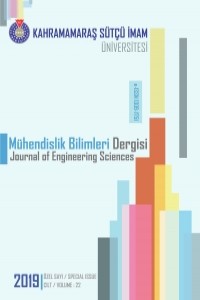Öz
Tahıl
ürünlerinin işlenmesinde sonra kepek kısmı genellikle atık olarak kalmaktadır.
Ancak son yıllardaki çalışmalar bu atıkların katma değerli ürünler olduğunu
göstermiştir. Bu çalışmada farklı boyutlarda kinoa kepek unu kullanımının
keklerin fiziksel, tekstürel ve duyusal özellikleri üzerine etkilerinin
belirlenmesi amaçlanmıştır. Bu amaçla farklı boyutlarda kinoa kepek unları
değirmende öğütülmüş ve 5 farklı oranda keklere katılmıştır. Elde edilen
sonuçlara göre kinoa kepek ununun boyutları küçüldükçe keklerin kuru madde
oranı artmıştır. Keklerin tekstürel özellikleri kontrol örneğine benzerlik
göstermiş, ancak yapışkanlık en küçük boyutta artış göstermiştir. Duyusal
analizlerde, kinoa kepek unu kullanımı olumsuz etkilere neden olmaz iken,
boyutun küçülmesi, daha iyi sonuç vermiştir. Bu
çalışma kinoa kepek unun kek formülasyonunda kullanılabilirliğini göstermiştir.
Anahtar Kelimeler
Duyusal özellikler Kinoa Tekstür profile analizi Kek Zenginleştirme
Kaynakça
- Algosaibi, A.M., Badran, A.E., Almadini, A.M., El-Garawany, M.M. (2017). The effect of irrigation intervals on the growth and yield of quinoa crop and its components, Journal of Agricultural Science, 9, 182-191.
- Alvarez-Jubete, L., Arendt, E.K., Gallagher, E. (2009). Nutritive value and chemical composition of pseudocereals as gluten-free ingredients, International Journal of Food Sciences and Nutrition, 60, 240-257.
- Caperuto, L.C., AmayaFarfan, J., Camargo, C.R.O. (2001). Performance of quinoa (Chenopodium quinoa Willd) flour in the manufacture of gluten-free spaghetti, Journal of the Science of Food and Agriculture, 81, 95-101.
- Escribano, J., Cabanes, J., Jiménez-Atiénzar, M., Ibañez-Tremolada, M., Gómez-Pando, L. R., García-Carmona, F., Gandía-Herrero, F. (2017). Characterization of betalains, saponins and antioxidant power in differently colored quinoa (Chenopodium quinoa) varieties, Food Chemistry, 234, 285-294.
- Föste, M., Nordlohne, S.D., Elgeti, D., Linden, M.H., Heinz, V., Jekle, M., Becker, T. (2014). Impact of quinoa bran on gluten-free dough and bread characteristics, European Food Research and Technology, 239, 767-775.
- Lorenz, K., Coulter, L. (1991). Quinoa flour in baked products, Plant Foods for Human Nutrition, 41, 213-223.
- Navruz-Varli, S., Sanlier, N. (2016). Nutritional and health benefits of quinoa (Chenopodium quinoa Willd), Journal of Cereal Science, 69, 371-376.
- Paśko, P., Bartoń, H., Zagrodzki, P., Gorinstein, S., Fołta, M., Zachwieja, Z. (2009). Anthocyanins, total polyphenols and antioxidant activity in amaranth and quinoa seeds and sprouts during their growth, Food Chemistry, 115, 994-998.
- Ruiz, K. B., Biondi, S., Oses, R., Acuña-Rodríguez, I. S., Antognoni, F., Martinez-Mosqueira, E. A., Coulibaly, A., Canahua-Murillo, A., Pinto, M., Zurita-Silva, A. (2014). Quinoa biodiversity and sustainability for food security under climate change. A review, Agronomy for Sustainable Development, 34, 349-359.
THE EFFECT OF DIFFERENT SIZED QUINOA BRAN FLOUR USAGE ON THE PHYSICAL, SENSORY AND TEXTURAL PROPERTIES OF CAKES
Öz
After the processing of
cereal products, the bran part is commonly considered as waste. However, recent
studies have shown that this waste can be processed into value-added products.
The aim of this study was to investigate the effects of quinoa bran flour with
different particle sizes on physicochemical, textural and sensory properties of
cakes. For this purpose, quinoa bran flours were milled to 5 different particle
sizes and added to the wheat flour cakes at a constant level (25% of wheat
flour). According to the results, the dry matter contents of the samples
increased as the particle size of the quinoa bran flour decreased. Similarly, a
decrease in the crumb and crust color values of the cake was observed depending
on the bran particle size. The textural and sensory characteristics of cake
samples were decreased. This study reveals the changes in the properties of
cakes enriched with different sized quinoa bran flour.
Anahtar Kelimeler
Kaynakça
- Algosaibi, A.M., Badran, A.E., Almadini, A.M., El-Garawany, M.M. (2017). The effect of irrigation intervals on the growth and yield of quinoa crop and its components, Journal of Agricultural Science, 9, 182-191.
- Alvarez-Jubete, L., Arendt, E.K., Gallagher, E. (2009). Nutritive value and chemical composition of pseudocereals as gluten-free ingredients, International Journal of Food Sciences and Nutrition, 60, 240-257.
- Caperuto, L.C., AmayaFarfan, J., Camargo, C.R.O. (2001). Performance of quinoa (Chenopodium quinoa Willd) flour in the manufacture of gluten-free spaghetti, Journal of the Science of Food and Agriculture, 81, 95-101.
- Escribano, J., Cabanes, J., Jiménez-Atiénzar, M., Ibañez-Tremolada, M., Gómez-Pando, L. R., García-Carmona, F., Gandía-Herrero, F. (2017). Characterization of betalains, saponins and antioxidant power in differently colored quinoa (Chenopodium quinoa) varieties, Food Chemistry, 234, 285-294.
- Föste, M., Nordlohne, S.D., Elgeti, D., Linden, M.H., Heinz, V., Jekle, M., Becker, T. (2014). Impact of quinoa bran on gluten-free dough and bread characteristics, European Food Research and Technology, 239, 767-775.
- Lorenz, K., Coulter, L. (1991). Quinoa flour in baked products, Plant Foods for Human Nutrition, 41, 213-223.
- Navruz-Varli, S., Sanlier, N. (2016). Nutritional and health benefits of quinoa (Chenopodium quinoa Willd), Journal of Cereal Science, 69, 371-376.
- Paśko, P., Bartoń, H., Zagrodzki, P., Gorinstein, S., Fołta, M., Zachwieja, Z. (2009). Anthocyanins, total polyphenols and antioxidant activity in amaranth and quinoa seeds and sprouts during their growth, Food Chemistry, 115, 994-998.
- Ruiz, K. B., Biondi, S., Oses, R., Acuña-Rodríguez, I. S., Antognoni, F., Martinez-Mosqueira, E. A., Coulibaly, A., Canahua-Murillo, A., Pinto, M., Zurita-Silva, A. (2014). Quinoa biodiversity and sustainability for food security under climate change. A review, Agronomy for Sustainable Development, 34, 349-359.
Ayrıntılar
| Birincil Dil | Türkçe |
|---|---|
| Konular | Gıda Mühendisliği |
| Bölüm | Araştırma Makalesi |
| Yazarlar | |
| Yayımlanma Tarihi | 29 Kasım 2019 |
| Gönderilme Tarihi | 16 Eylül 2019 |
| Yayımlandığı Sayı | Yıl 2019 Cilt: 22 - Özel Sayı |

